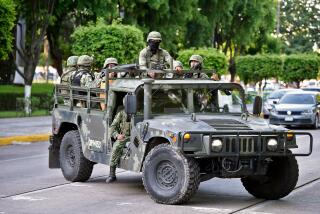Contras’ Border Clashes With Sandinistas End
Fighting between Sandinista troops from Nicaragua and U.S.-backed Nicaraguan rebels has ended inside Honduras, and the Honduran armed forces ordered the rebels back to their frontier base camps, sources with access to intelligence information said Thursday.
Most of the Sandinistas who entered Honduras during the past week have slipped back to Nicaragua, U.S. officials in Honduras said. Estimates of the numbers of Nicaraguan troops that battled the contras, as the rebels are called, were more than halved--to about 700 from the earlier figure of 1,500.
In Managua, the Defense Ministry said Sandinista troops destroyed the contras’ main training camp in border fighting. (Page 10.)
On Thursday, Honduran troops were deployed at several bases just outside the mountainous area where the fighting was reported to have taken place during the last five days--about 150 miles east of Tegucigalpa, the capital.
This show of force did not seem to include plans to pursue any remaining Nicaraguans. Reporters visiting a newly established government outpost here in Capire, a remote mountain village turned into a helicopter base, saw no indications that the Hondurans were eager to cut off Sandinista stragglers.
Sources said that there were no Honduran army sweeps under way, and Honduran troops passing Capire said that they heard of no plans to pursue.
During the last two days, U.S.-piloted helicopters have ferried about 750 Honduran troops to outposts near the Nicaraguan border. U.S. troops also guarded the outskirts of at least one runway that served as a way station for the airlift, and on Thursday, the commander of U.S. troops based in Honduras, Col. Larry Gragg, visited Capire.
Instead of mopping-up operations, the Hondurans seemed to be engaged in a kind of propaganda exercise.
During a briefing for reporters in a farmhouse here, Honduran officers said that no contras operated in the area. They claimed not to know of the contras training camp, called the Center for Military Instruction, where most of the fighting was said to have taken place.
The center is about 10 miles east of Capire.
“I have never seen a contra,” declared Col. Danilo Carvajal.
For that, he needed only to walk 10 minutes west to find not only plenty of contras, but a rebel hospital under a large olive green tent. A jeep bearing the families of two contras drove by the farmhouse where Carvajal spoke minutes before the briefing.
At all events, information in Honduras about the fighting was highly colored by political considerations.
Honduras is sensitive to criticism that it is supporting efforts to overthrow a neighboring government on behalf of the United States. The fighting between the Sandinistas and the U.S.-backed contras has highlighted Honduran hospitality to the rebels.
The order for the contras to return to their bases was meant to calm the situation and keep Honduran troops from appearing to be either protecting or working with the contras, military sources said.
In the past, after border incidents between the rebels and Sandinistas, the Hondurans have insisted that the contras shift their bases farther away from the frontier so as not to invite Sandinista attacks. About 6,000 rebels are reported to be in Honduras.
The reporters’ trip to Capire was meant to prove that the Sandinistas had invaded Honduras. Collection of the proof was attributed, however implausibly, to the Honduran army and not to the contras, because Honduras officially maintains that none of the U.S.-backed rebels operate in this country.
On Thursday, Honduran Maj. Miguel Angel Ramirez showed reporters five fly-covered cadavers that he said were the bodies of Sandinista troops. He said that the men, attired in fatigues, were killed two days earlier by Honduran patrols.
This was unlikely since the Hondurans arrived in this mountainous region only on Wednesday. Col. Gragg, the U.S. commander, said that the five were killed by contras.
Numerous weapons also shown to reporters included one SAM-7 missile launcher, several Soviet-made AK-47 rifles and machine guns. Yugoslavian canned meat, Canadian medicines, canteens, bullets and bedsheets marked “Popular Sandinista Army” were also on display. All were reported captured by the contras.
Several peasants from surrounding villages said that they had heard firing in the mountains during the last weekend, but none witnessed any combat.
The heads of two families traveling past Capire in a closed jeep said they belonged to the Nicaraguan Democratic Force, the largest of the Nicaraguan rebel groups. They said they had not fought the Sandinistas. They said they had heard of the combat but had not fought themselves. They were both armed with worn M-1 rifles.
The two contras claimed to have seen numerous dead Sandinistas outside the Center for Military Instruction. Few prisoners were taken, they added.
Reporters who slipped away from the briefings and walked down a dusty road got a clear look at the contras hospital. Local Honduran peasants directed them there.
Men dressed in the bluish uniforms of the Nicaraguan Democratic Force were clearly visible.
Unarmed guards who identified themselves as Nicaraguans and wore blue and white pins that are replicas of the Nicaraguan flag barred the reporters from entering the grounds.
One of the guards, Pascual Espinosa, said he was from the San Judas neighborhood of Managua and had fled Nicaragua to join the contras six months ago.
Espinosa, 45, said that before the Sandinistas came to power, he served in the National Guard of Nicaraguan dictator Anastasio Somoza. After Somoza was ousted by the Sandinista revolution in 1979, Espinosa said that he tried farming but that the Sandinistas had confiscated his land.
Espinosa said he had received no military training and was not involved in the recent combat. “It was supposed to be very heavy,” he said, but he declined to say whether any wounded or dead were brought to the hospital near Capire.
More to Read
Sign up for Essential California
The most important California stories and recommendations in your inbox every morning.
You may occasionally receive promotional content from the Los Angeles Times.





